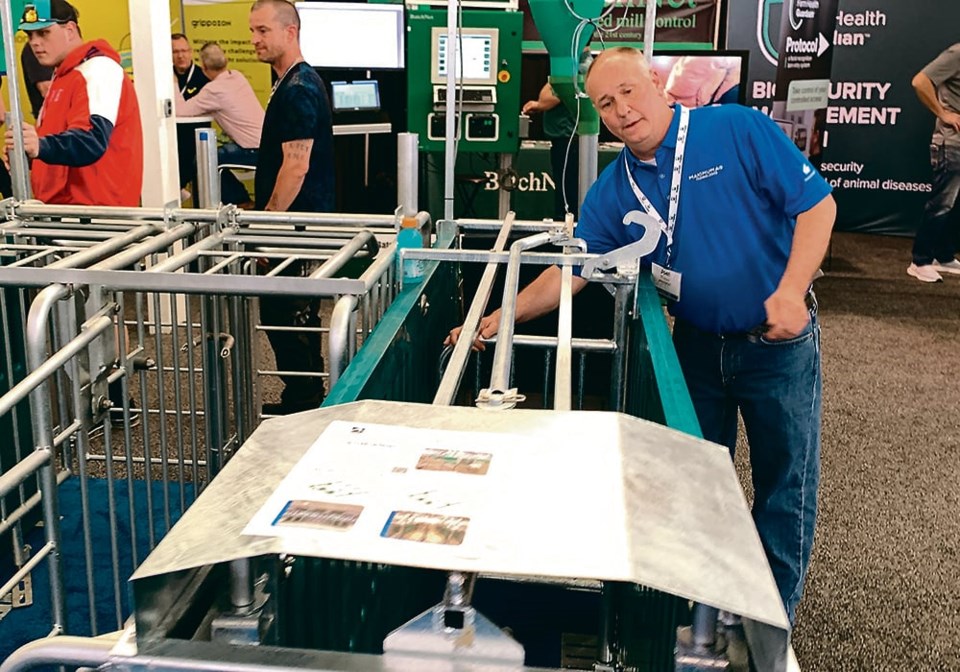DES MOINES, Iowa — The PigTek company isn’t shy about confronting most hog producers’ biggest worry when it comes to building or renovating a pig barn.
“Proposition 12 Compliant,” it claims on a big sign in the front of its display area in the main building for the World Pork Expo, which was held June 7-9 in Des Moines.
“Prep for any ‘Prop’ that comes your way.”
At another floor display, the representatives of Manitoba’s Crystal Spring hog facilities manufacturing company are demonstrating their open housing systems to Mexican and German hog producers, who are at the sprawling event to pick up ideas, leads and connections.
On the next row over, several hog producers from around the world are checking out the open housing systems offered by Quebec’s Maximus, a leading provider of stalls, electronic sow feeders and barn control systems.
“Prop 12 keeps getting producers to ask how, how, how can we get from stalls to open housing?” said Joel Phelps of Maximus in an interview inside the trade show.
“What changes do we have to make? How many do we have to make? How soon do we have to make them?”
For Phelps, the answers aren’t definitive. He gives producers the best guess on what California’s and other state regulations will probably require, but much is still unknown.
“Here’s what we have. Here’s what we think we have to go to. But it’s not a clear direction.”
That’s because California’s Prop 12 regulations are not yet completely clear, so few people are sure they can meet their rules for open housing for gestating sows. The regulations will declare how many sq. feet per sow are required within a barn, which is expected to be more than most open housing barns today provide.
Also, sows may be held in a breeding stall for a few hours after insemination, but the regulations are expected to allow far fewer hours than producers like to use to avoid preventable miscarriages.
The worries about Prop 12 are just one serious issue confronting producers. At the World Pork Expo, farmers and industry people had to juggle concerns about foreign animal diseases such as African swine fever, financial challenges from soaring production costs, trade worries from both Prop 12 and new voluntary country-of-origin labelling rules С����Ƶ developed, chronic labour shortages and a host of other concerns.
“We’ve got a lot of pressure,” Terry Wolters, an independent hog producer, who had just finished his term as National Pork Producers Council president, said in an interview at the end of the expo.
“Producers are in a really challenging spot.”
Corn prices have shot higher, while pork prices have slid recently, so many producers take losses every time they sell a pig fed on corn bought in the last year.
Interest rates make borrowing money to renovate or build a barn seem prohibitively expensive. When the increasing price of labour and materials are added, few farmers can justify doing much more than managing what they’ve already got.
Prop 12 is vexing many people because producers will need to have compliant facilities to deliver California-bound pigs to packers. California consumes only 13 to 15 percent of U.S. pork. Since pigs are cut up after slaughter and the meat goes to various states, it’s hard to see how premiums for California pork will justify higher production costs for the 85 percent of pork going to markets that don’t require them, Wolters said.
“I don’t sell 13 to 15 percent of my pigs to California. It’s cuts, it’s broken up,” said Wolters.
African swine fever is a grave concern to the industry because it has arrived in the Caribbean and could appear in North America at any time. That would cause a major market disruption because foreign borders would close and hog movement would be banned for some time. Hog farmers saw that happen in the early stages of the pandemic.
Yet the industry saw good returns and much rebuilding before the recent slump in hog margins.
The hog industry faces more volatility than any other mainstream farming industry in North America, and after decades of consolidation, no faint-hearted producers are likely left.
That has created a pool of producers able to face constant challenges while remaining optimistic, although today’s problems mean some of the older farmers with aged facilities are likely to quit rather than invest in renovating their barns for Prop 12 or run at a loss until profitability returns.
“There will be some exit of producers in this downturn in the market,” said Wolters.
But for the producers and companies committed to the industry, the future was the focus, even if it’s hard to figure out its shape today.
Like the other manufacturers and service providers at the expo, Maximus is proud of its stuff and enjoys showing it off to producers. But with all the uncertainty right now, a lot of its work is getting producers ready for what they’ll be installing once there’s enough confidence to proceed, rather than inking contracts to install systems tomorrow.
“It’s a lot of quotes and drawings and changes,” said Phelps.




